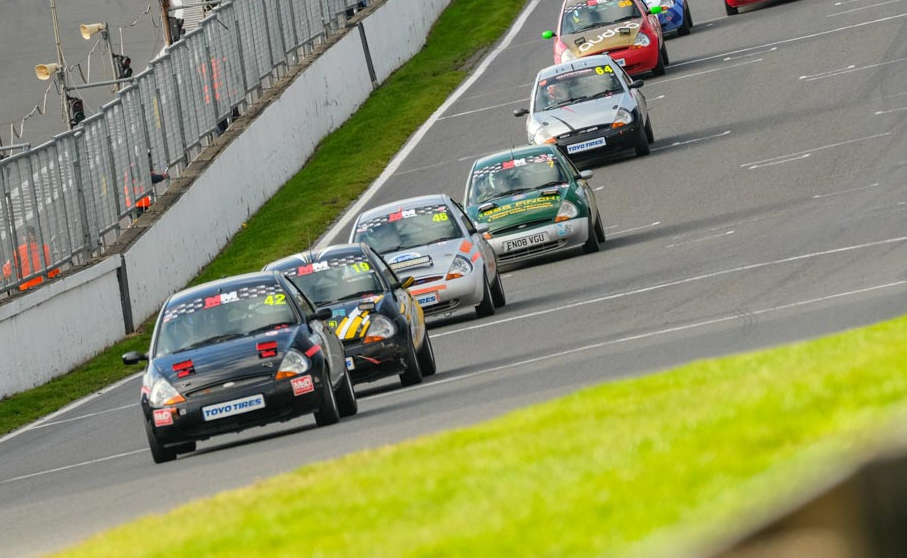If you want to experience a whole new level of appreciation for what old cars can do, says Paul Cowland, then take them racing.
Sit in even the cheapest new car on sale today and you will be surrounded by a plethora of airbags, seatbelt pre-tensioners, crumple zones and safety cages. New cars are incredibly safe, which is something we should all be thankful for, but all of that mild-steel bubble wrap comes at a cost. And that cost is weight.

Weight ruins everything. Just ask the engineers behind cars like the Caterham Seven and Lotus Elise. It blunts acceleration, makes brakes and tyres work harder, and as there’s more mass to throw around in the corners, the handling suffers too. Jump straight from say, your modern Golf Mk8 into its 1990 counterpart and you’ll see just how lardy modern cars have become. Although the latest Golf has much more power, it’s also carrying the best part of half a tonne of extra weight. And you’ll always feel that.
It’s for this reason above all others, that the ’70s, ’80s and ’90s hot hatches and performance cars that we love so much feel so alive on our favourite roads. Many don’t even have power steering, giving you a visceral connection to the rack, brakes are easy to modulate once set up properly, and although power outputs would be embarrassing to many entry-level shopping cars these days, they’ve all got more than enough to shovel them along – particularly if you’re looking to stay within the speed limit.
That rationale also means that these classics often make superb track and race cars. They have a small footprint, insignificant mass and an immediacy of control that puts the driver at the very heart of proceedings. It was this reasoning that initially saw me build my first Golf Mk2 racing car almost 15 years ago, for series including the Production GTI and Toyo Tires Racing Saloons championships – and I haven’t been without one since. Over several seasons, one almighty crash aside, that car became as comfortable to me as the gloves and boots I pulled on before each race. You don’t drive that car, so as much as wear it.
When building a classic race car, you also get to address the only real downside to older motors; safety. With a substantial roll cage around you, race seats, harnesses, a HANS device and a barrage of fire extinguishers, a classic racer gives you the best of both worlds; the style, substance and character of a much cooler design period – only with the safety blanket of confidence that if it all goes horribly wrong, you’re more than likely to step away from it all with just a slight sense of embarrassment (and impending poverty) to overcome, given sponsor graphics and your name in the back window can look a little out of place on a road-registered car.
These days though, a decent Mk2 Golf is worth quite a bit of coin, with certain parts being harder to find, so it’s not as easy to take one clubman racing on a shoestring as it was when I began. I started to look at other championships and cars, and found my classic racing fix in the most unlikely of places.
That moment came with a car that had never really been on my radar – until I saw 50 of them, caged, liveried and on three wheels through Paddock Hill bend at Brands Hatch. What was it? The humble Ford Ka.

Believe it or not, this shopping chariot so favoured by the Saga classes and first time drivers, turns out to be an absolute hoot once race-prepped. The EnduroKa series runs its races in an endurance format, with 8, 12 and even 24 hour races, complete with Le Mans-style driver changes. All cars are strictly capped with affordable modifications and safety features meaning a competitive car can be built for around £6000 to £7000 if you don’t mind getting the socket set out. The most expensive cars on the grid, with everything refreshed, cost around £10,000. In short, it’s just about the most amount of seat time there is in a cheap-to-run-and-fix car available in British motorsport. It’s probably why a few well-known ex-BTCC stars have even tried their hands at it!
Public roads have never been the place for driving a car to its limits. And as roads become ever-more populated with speed cameras and road safety initiatives, I think it’s cost-effective race series and championships like these that hold the future for us petrolheads. Driving at the absolute limit, tyres on fire, in a gaggle of 10 other cars with exactly the same power as you is a thrill that never gets old.
So how about this for a New Year’s resolution? Make it the year you get a race licence – and start doing it for real. Even with only 56bhp, I promise you’ll enjoy some of the best driving you’ll ever have.
Read more
Saint Cowland of Cars and his ever-growing flock
Join a car club? Not until they can all get along
Convert a classic to electric? It’s assault and battery








